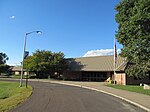Mill–Prospect Street Historic District

The Mill–Prospect Street Historic District in Hatfield, Massachusetts encompasses a historic landscape with over 300 years of industrial and agricultural history. It was listed on the National Register of Historic Places in 2002. The district runs along Prospect Street, a north-south road that roughly bisects Hatfield, from its southern end at Elm Street to a point north of its junction with Chestnut Street, and includes properties on adjacent roadways. The central focus of the district is the Mill River, which meanders from west to east across the district's middle. At the Prospect Street crossing is a cluster of former late 19th century industrial buildings, some of which comprise the Old Mill Site Historic District, listed in 1982.
Excerpt from the Wikipedia article Mill–Prospect Street Historic District (License: CC BY-SA 3.0, Authors, Images).Mill–Prospect Street Historic District
Chestnut Street,
Geographical coordinates (GPS) Address Nearby Places Show on map
Geographical coordinates (GPS)
| Latitude | Longitude |
|---|---|
| N 42.375277777778 ° | E -72.613055555556 ° |
Address
Chestnut Street 45
01038
Massachusetts, United States
Open on Google Maps










